Hummingbirds are not just some of the tiniest birds on Earth; they are among the most fascinating, displaying dazzling plumage and incredible flight capabilities. From their iridescent feathers to their rapid wing beats, hummingbirds captivate anyone who witnesses their acrobatic antics. With over 300 species scattered across the Americas, these beautiful creatures range from the vibrant and colorful to the rare and elusive. In this article, we will explore 10 of the most stunning hummingbird species, each with its own unique features and captivating beauty. Get ready to learn more about these winged gems.
The marvelous spatuletail (Loddigesia mirabilis) is undoubtedly one of the most extraordinary hummingbirds in existence. Native to the northern Andes of Peru, this species is known for its remarkable tail feathers. The male Marvelous Spatuletail can reach a length of 6.7 inches, with its two outer tail feathers stretching up to an incredible 5.1 inches. These tail feathers are flattened at the tips and resemble small spatulas, making them particularly striking when the bird performs its courtship display.
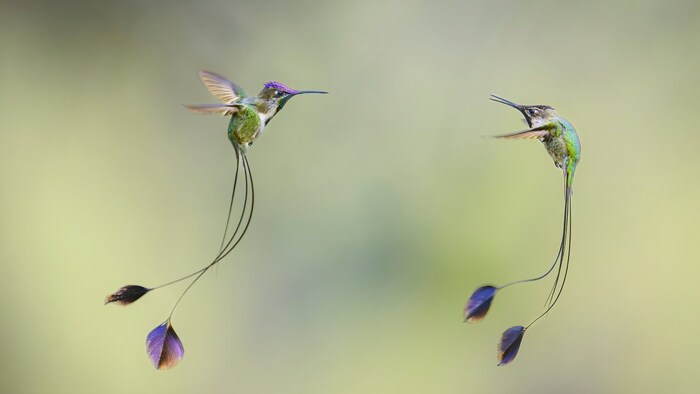
Males use their tail feathers in elaborate aerial dances to attract mates, often flying in vertical loops while showing off their vibrant plumage. Females, in contrast, have shorter tails and lack the exaggerated tail feathers of the males. While the Marvelous Spatuletail is a truly beautiful bird, it is sadly listed as endangered. Habitat loss, deforestation, and climate change pose serious threats to their survival, making it essential for conservation efforts to protect this magnificent species.
These hummingbirds are known to feed on the nectar of various flowers, including the Peruvian Lily and the Mupa Mupa tree. They also eat small insects and spiders, providing them with the necessary protein to fuel their high-energy lifestyle.
ruby-topaz hummingbird (Chrysolampis mosquitus),Found across regions in South America, including Bolivia, Venezuela, and Aruba, the Ruby-Topaz Hummingbird is a brilliant and colorful species that stands out among other hummingbirds. The male features an eye-catching combination of dark brown upperparts, a yellow neck, and a brilliant red crown. The rest of the underparts are a mix of brown and black, with a shimmering effect that catches the light beautifully.
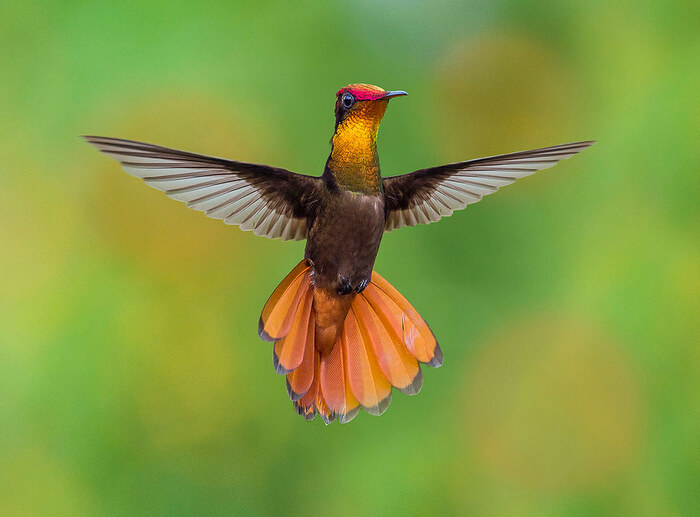
This species grows to about 4 inches in length and is known for its territorial nature. Males aggressively defend their feeding areas from other males, engaging in dramatic aerial battles. Like most hummingbirds, the Ruby-Topaz Hummingbird feeds on nectar from a wide variety of flowering plants, especially those that offer high sugar content, such as the flowers of the Samman tree and Ixora plants. In addition to nectar, these hummingbirds also consume insects and spiders to supplement their diet with protein.
Ruby-Topaz Hummingbirds are highly active during the day, beating their wings rapidly to hover and dart between flowers. Their wingbeats are so fast that they produce a characteristic humming sound, which is where their name comes from.
The rufous-crested coquette (Lophornis delattrei) is one of the smallest hummingbird species, measuring only about 2.5 inches in length. Native to Central and South America, particularly in areas like Costa Rica and Panama, this hummingbird is a true marvel in terms of agility and beauty. Its defining feature is the rufous-colored crest on the male's head, which contrasts beautifully with its bright green body.
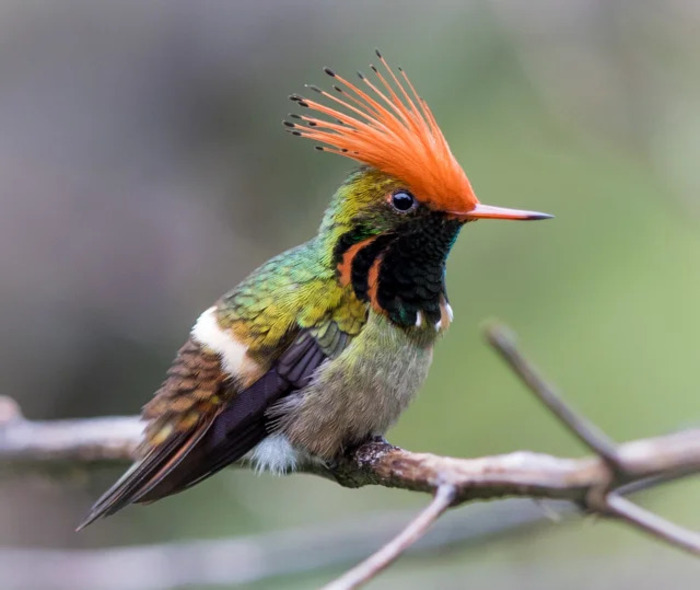
Females are less colorful than males but still exhibit a mix of green and white feathers. The Rufous-Crested Coquette is a skilled nectar feeder, using its long bill to sip nectar from various brightly colored flowers. It also consumes small insects and spiders, which provide much-needed protein.
Known for their rapid and erratic flight patterns, Rufous-Crested Coquettes are incredibly agile. They are often seen flitting between flowers with impressive speed, and their small size allows them to hover in one spot with remarkable precision.
Costa’s Hummingbird(Calypte costae) is one of the most stunning hummingbirds found in the southwestern United States, primarily in Arizona, California, and parts of Mexico. Males of this species are easily identifiable by their iridescent purple throat, which contrasts with their white underparts. They also have a long, straight bill and a slightly curved tail, adding to their sleek and elegant appearance.
Males are particularly territorial, defending their feeding areas from other males by performing aerial displays and calling loudly to assert their dominance. The Costa’s Hummingbird feeds on nectar from a variety of plants, especially those with high sugar content, such as agave flowers and cacti. It also consumes insects and spiders for protein.
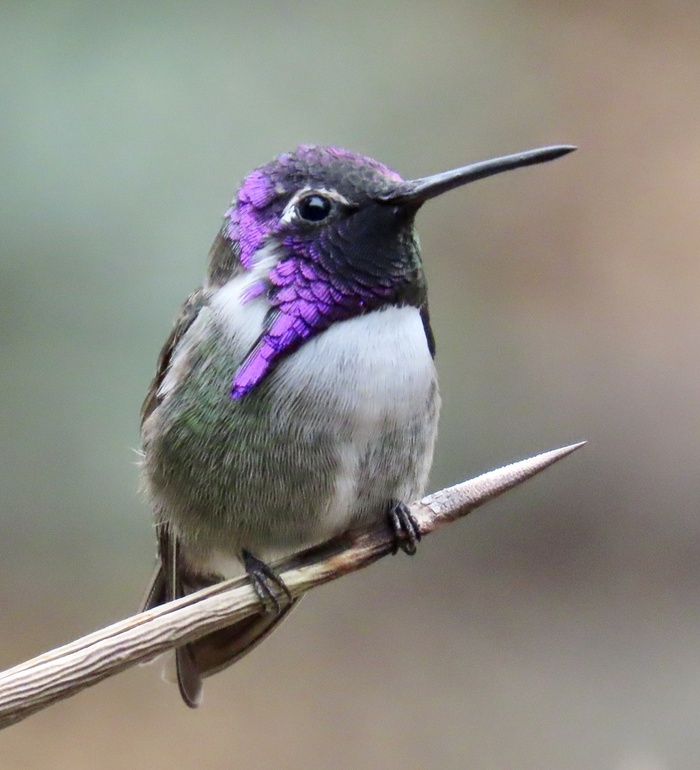
These hummingbirds are especially active during the daytime, constantly on the move as they search for food. Known for their distinctive buzzing sound, they make a quick, sharp chirp when flying at high speeds. Costa’s Hummingbird is also unique for its ability to thrive in arid desert environments, where food sources can be scarce.
The blue-throated hillstar (Oreotrochilus cyanolaemus) is a rare and beautiful hummingbird species found in the high-altitude regions of South America, including Colombia, Ecuador, and Bolivia. This species inhabits the elfin forests and shrublands at elevations of 2,800 to 4,500 meters (9,000 to 14,800 feet), where it feeds primarily on the nectar of alpine flowers.
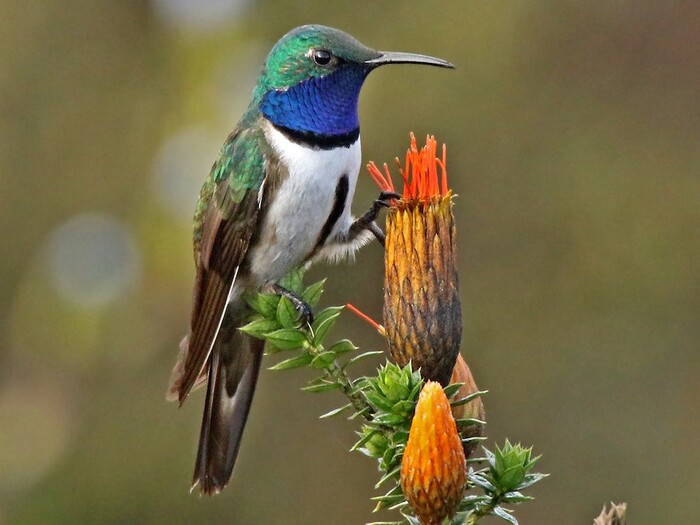
Males are known for their striking blue throats, which stand out against their greenish bodies. In addition to nectar, they also feed on small insects and spiders, which provide additional protein. Like many hummingbirds, Blue-Throated Hillstars are territorial and fiercely defend their feeding grounds from other birds.
These birds have adapted to life at high altitudes, where they are exposed to cooler temperatures and harsher weather conditions. Their unique plumage and stunning coloration make them one of the most sought-after species for birdwatchers in the Andes.
The long-tailed sylph (Aglaiocercus kingii) is another exceptional hummingbird from the Andes mountains. Known for its extraordinarily long tail feathers, this species is considered one of the most beautiful hummingbirds in the world. Males of this species can have tails that are up to twice the length of their body, giving them a dramatic appearance when flying.
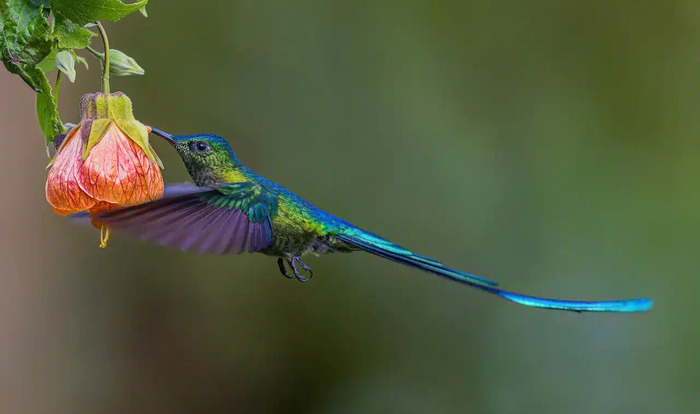
This migratory bird moves up and down the slopes of the Andes throughout the year, seeking out the best food sources at different altitudes. The Long-Tailed Sylph feeds on nectar and small insects, and it plays a crucial role in pollinating the flowers it visits.
Unfortunately, Long-Tailed Sylphs are facing population declines due to habitat destruction and climate change. Their specialized habitat in the Andean mountains makes them particularly vulnerable to environmental shifts, highlighting the need for conservation efforts.
Also known as the Snowcap (Microchera albocoronata), the White-Crowned Hummingbird is one of the smallest hummingbird species, measuring only 2.5 inches long. This tiny bird is found in the forests of southern Honduras and Panama, where it feeds on nectar and small insects. The most distinctive feature of the male is its brilliant white cap, which contrasts beautifully with its dark plumage.
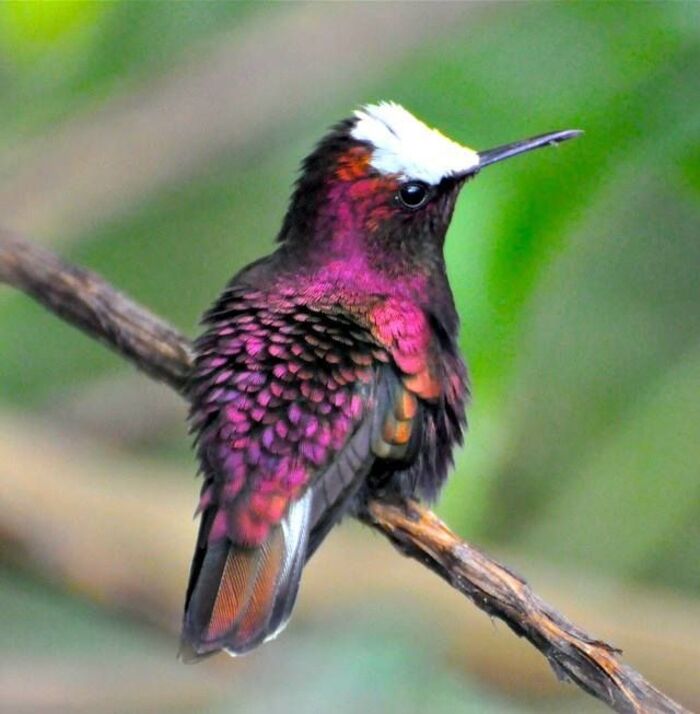
These birds have an impressive metabolism, and they need to feed frequently to maintain their energy levels. White-Crowned Hummingbirds are highly territorial and will defend their feeding areas from other males. Their tiny size and rapid flight make them a joy to observe in their natural habitat.
The green-crowned brilliant (Heliodoxa jacula) is one of the most colorful hummingbirds found in Central and South America. Native to regions such as Colombia, Costa Rica, and Panama, these birds are known for their striking green and blue plumage. Males are particularly beautiful, with an iridescent green crown and a bright violet-blue patch on their throat.
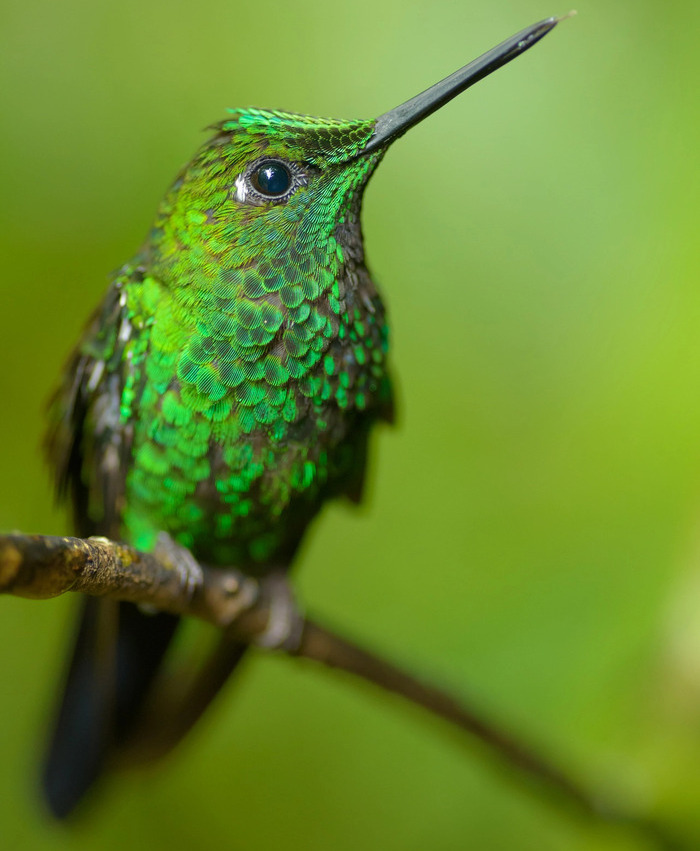
Green-Crowned Brilliants are typically found in humid forests, gardens, and forest edges at elevations between 700 and 2,200 meters. They feed primarily on nectar, but also consume small insects and spiders. These birds play a key role in pollinating the flowers they visit, making them an important species in their ecosystems.
green-tailed trainbearer (Lesbia nuna),Native to the high-altitude regions of the Andes mountains, the Green-Tailed Trainbearer is one of the most distinctive hummingbirds in South America. Males have long, iridescent green tail feathers that resemble a train, adding to their dramatic appearance. They also have a shiny green body and a slightly curved bill.
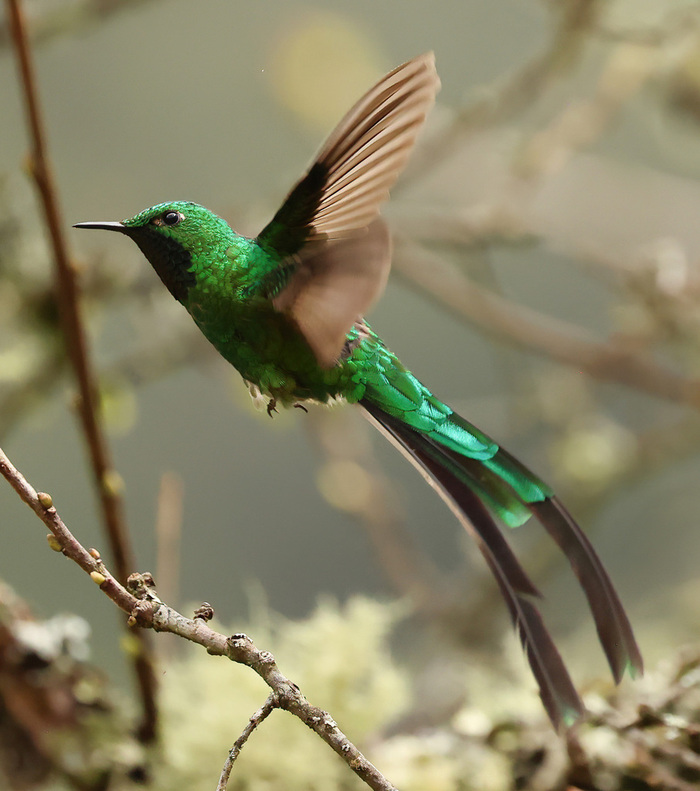
These hummingbirds are typically found in open areas, gardens, and forest edges in the Andes, where they feed on nectar and small insects. While the females are less colorful than the males, they still exhibit a beautiful mix of green and brown feathers. Like other hummingbirds, the Green-Tailed Trainbearer plays a vital role in pollination, ensuring the health of the ecosystem in which it lives.
The Purple-Bibbed Whitetip (Urosticte benjamini) is a small, stunning hummingbird native to the cloud forests of Colombia and Ecuador. Males of this species have a vibrant purple patch on their throat, which contrasts with their green and blue bodies. Both males and females have white-tipped tail feathers, giving them a unique and striking appearance.
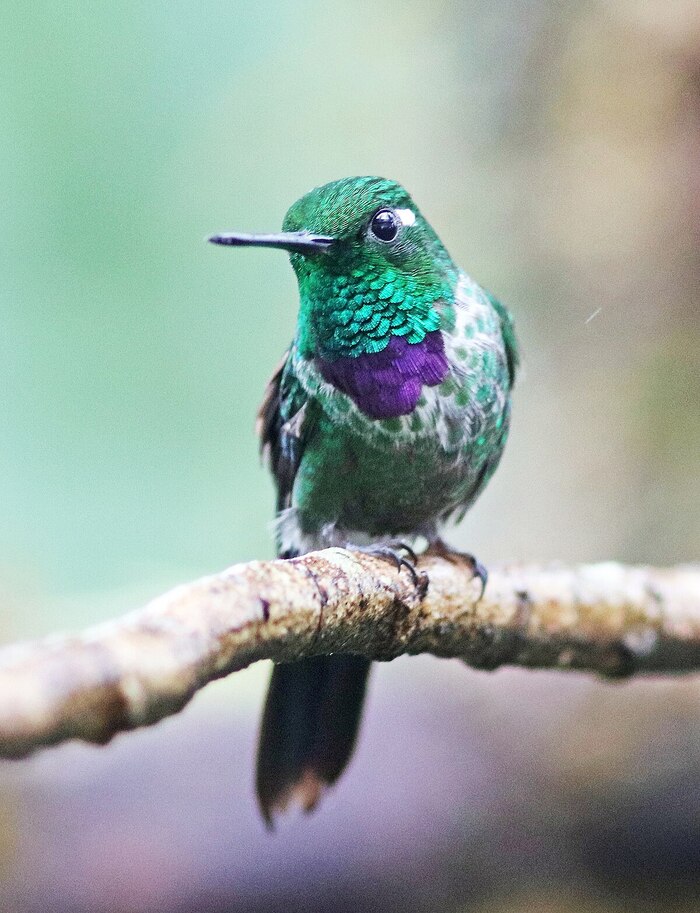
These birds are often seen flitting between flowers in their high-altitude habitat, feeding on nectar and small insects. Despite their small size, Purple-Bibbed Whitetips are highly territorial and will defend their feeding grounds from other hummingbirds. Their beautiful plumage and role in pollination make them an important species in the cloud forest ecosystem.
Hummingbirds are not only among the smallest birds in the world, but they are also some of the most spectacular. The Marvelous Spatuletail, Ruby-Topaz Hummingbird, Costa’s Hummingbird, and other species we’ve highlighted are just a few examples of the incredible diversity and beauty these birds bring to our planet. They serve as crucial pollinators, helping to maintain the balance of ecosystems throughout the Americas.
While hummingbirds' dazzling colors and fascinating behaviors make them beloved by birdwatchers, many of these species face serious threats due to habitat loss and climate change. Conservation efforts are essential to ensure these winged gems continue to thrive for generations to come.
Whether you are a seasoned birdwatcher or a newcomer to the world of hummingbirds, keep an eye out for these extraordinary species. Their beauty and ecological importance are well worth the effort to protect and preserve.
animal tags: Trochilidae
We created this article in conjunction with AI technology, then made sure it was fact-checked and edited by a Animals Top editor.